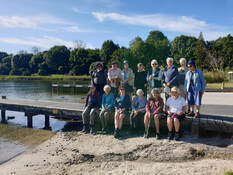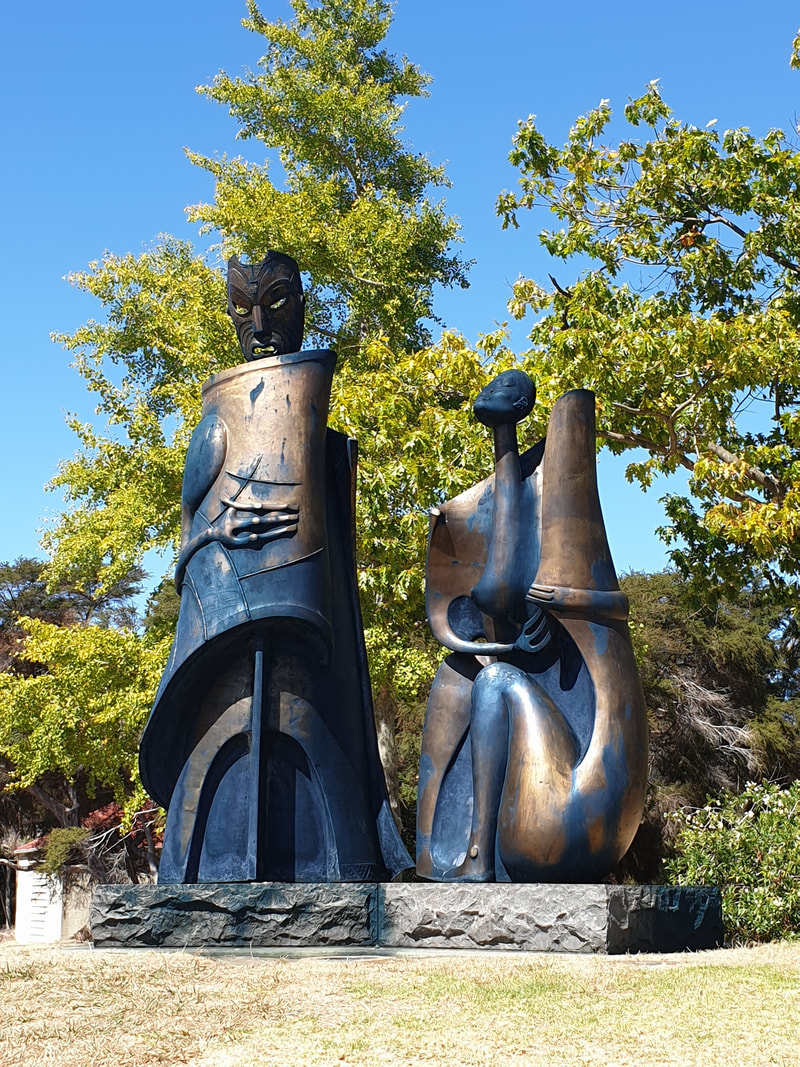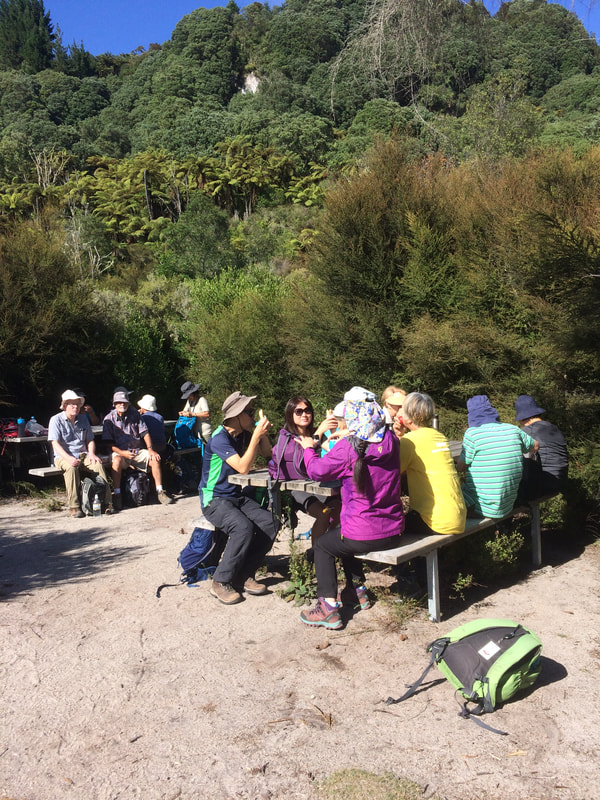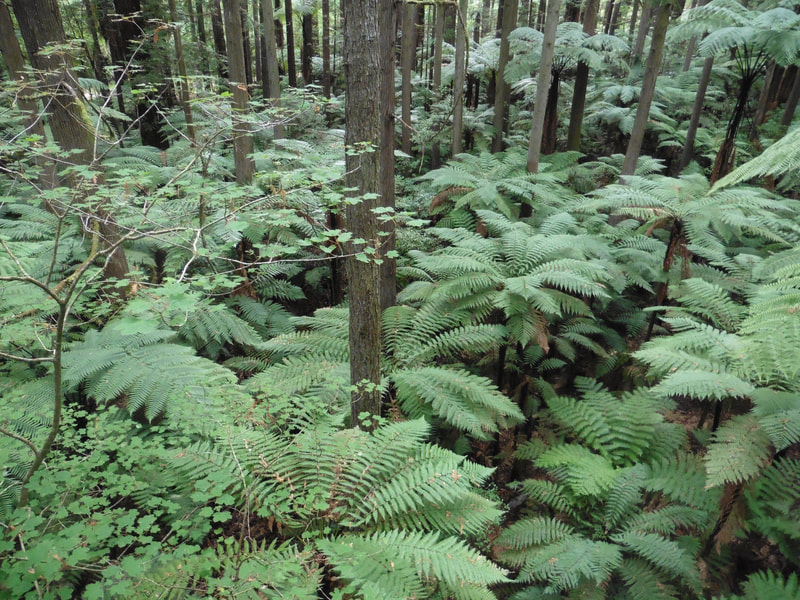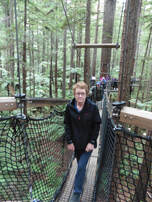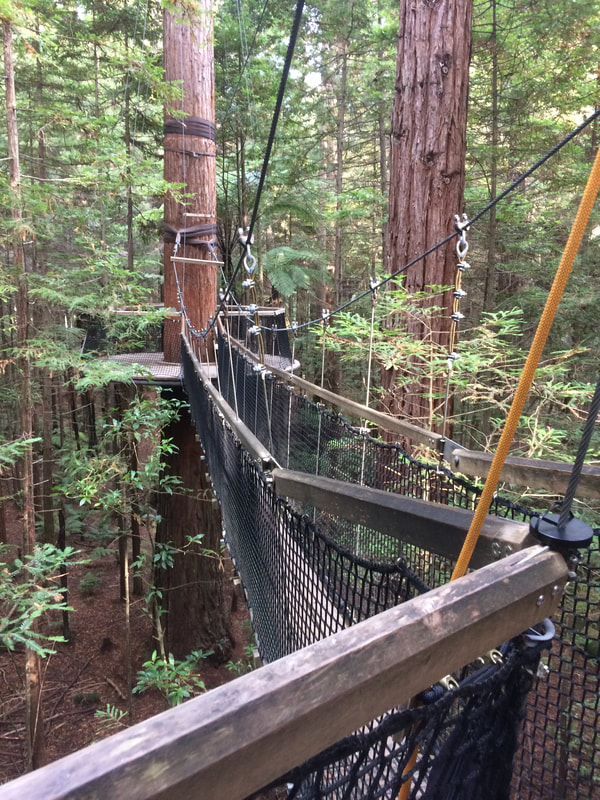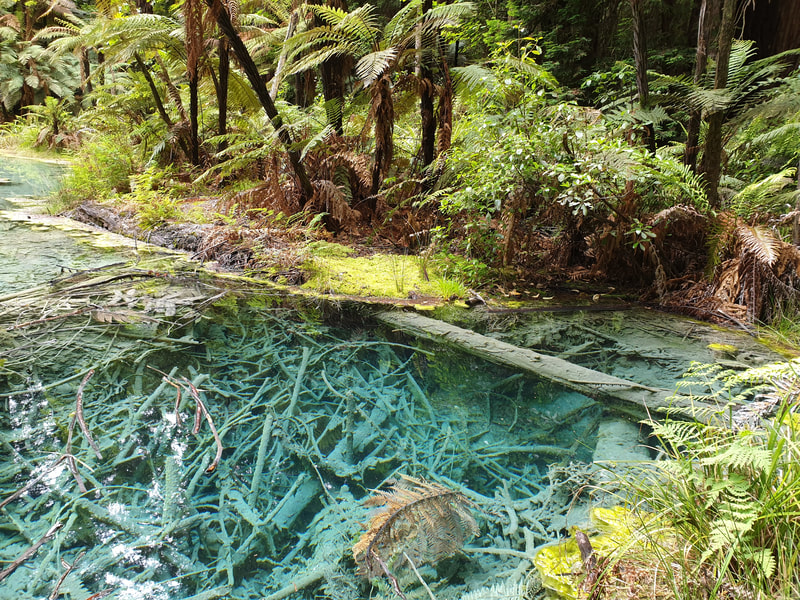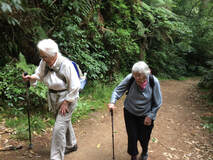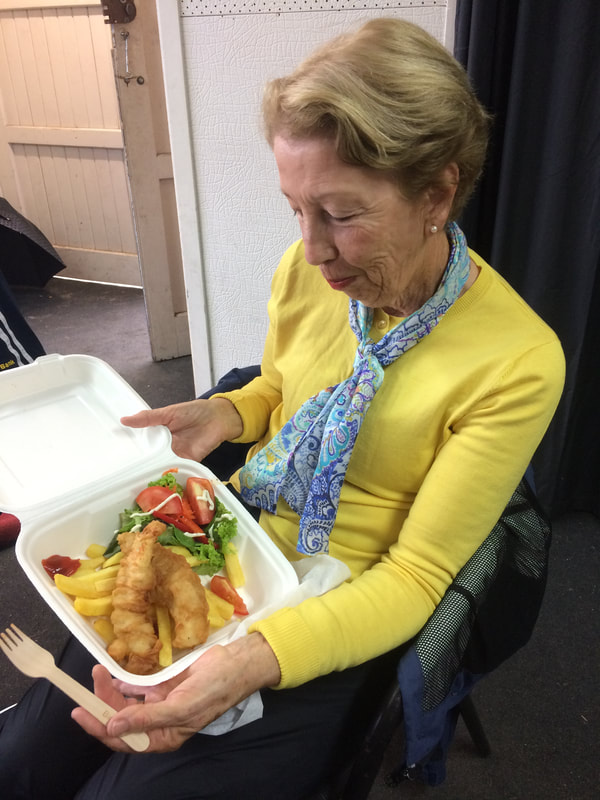ROTORUA : 07 - 10 March 2020
On a crisp, clear Saturday morning thirty-three club members boarded our bus to Rotorua with a high level of anticipation for the four days ahead.
DAY ONE
Waitakaruru Arboretum
 Dorothy & John - Artist Shelter
Dorothy & John - Artist Shelter
Twenty minutes south-east of Gordonton, we arrived at our first destination for the weekend – Waitakaruru Arboretum and Sculpture Park.
We were met by owners John and Dorothy Wakeling who explained how, since 1991, they have transformed an old overgrown quarry pit into the ecological restoration project it is today. The project has involved planting more than 20,000 trees and shrubs, many native New Zealand species as well as rare trees and shrubs from around the world.
We were met by owners John and Dorothy Wakeling who explained how, since 1991, they have transformed an old overgrown quarry pit into the ecological restoration project it is today. The project has involved planting more than 20,000 trees and shrubs, many native New Zealand species as well as rare trees and shrubs from around the world.
Left to our own devices, we followed the paths through the park admiring the vast variety of tree species as well as the sculptures on display (totalling over 100). At several points along the path, birdsong was evident. The growth of nectar and fruit-bearing trees has encouraged the return of tui, bellbirds and shining cuckoo with occasional visits from wood pigeons, kaka and herons.
We all met back at the Artist Shelter for lunch. John and Dorothy joined us again, they were great hosts – happy to answer any questions and they had the urn heated for us too!
Our next stop today......
Our next stop today......
Tikitapu Nature Walk
|
This reserve only a few minutes away from our final destination at the Blue Lake includes an easy thirty minute walk. The start of the loop track on the eastern side of Tarawera Road is set back from the road and reached after walking across a wide grassy area.
The Botanical Society, Royal Forest and Bird Protection Society and DOC all helped to create the track and now work together to control pests which threaten not only the native mistletoe but other plant and tree growth as well. The result of their work allows families, school groups and other walkers like us to learn about the reserve. |
|
Along the Nature Walk Track we read the identification labels and story panels which gave information about the birds, trees and the effects of the Mt Tarawera eruption. The bush was quite dense creating its own atmosphere in contrast to the bright afternoon sunlight we had just left. It was pleasing to see hinau growing so well. A tree we don’t often see on our walks.
Although the native mistletoe which can be found in the reserve wasn’t in flower in March we still found pleasure in the walk by enjoying the wonderful later afternoon birdsong, not heard in many bush reserves over recent years. |
 Kevin & Kanako -
Judy & Sharleen
Kevin & Kanako -
Judy & Sharleen
After we emerged from the bush we adjusted to the bright sunlight and walked
back across the grassy area to our bus for the quick trip down the hill to our accommodation at the Blue Lake Top 10 Holiday Park.
 Keen for Dinner
Keen for Dinner
Rooms allocated, we took the opportunity to freshen-up before coming together for happy hour and then heading out to an enjoyable dinner at Duke’s Bar & Restaurant in the historic Princes Gate Hotel.
DAY TWO
Lake Okareka Walkway
A peaceful lakeside walk off Acacia Rd, partly on a boardwalk over the wetlands, partly bush and gravel track, and a wonderful place to see lots of water birds and aquatic plants.
The cute hyperactive dabchicks were unmistakable with their long necks, bright yellow eyes and funny little jump before diving underwater for food. Amazing they can dive up to four metres and hold their breath for 40 seconds!
We spent around 90 minutes here but could have walked further, the track continues on beyond the boardwalk, a total of 2.5kms before you reach the end and need to turn round and return.
Natural Heritage Trail – Motutara Point to Rocky Point, Sulphur Bay
 Sulphur Bay trail
Sulphur Bay trail
Our first look at Lake Rotorua and a chance to experience a unique ecological area and wildlife refuge. You have to wonder how birds and plants can survive in this harsh geothermal environment. There’s no mistaking the typical Rotorua smell, and we also quickly noted the strange milky colour of the water in the bay which is caused by sulphur suspensions in the water.
This was another excellent place to see birdlife and also the rare prostrate kanuka which survives in the infertile geothermal soils, steam and toxic gases. In places the branches and trunks, and also the pine boardwalks are “burnt” black by the hydrogen sulphide present here.
Few insects and larvae can tolerate these acidic conditions - hence many of the bird species feed elsewhere around the lake, but nest here, and the geothermal warmth helps conserve energy usually used to keep their bodies warm.
Few insects and larvae can tolerate these acidic conditions - hence many of the bird species feed elsewhere around the lake, but nest here, and the geothermal warmth helps conserve energy usually used to keep their bodies warm.
It was surprising to see masses of the nationally threatened black-billed gulls on the shores of Sulphur Bay, this isn’t a beach! We walked beside steam vents (fumeroles), bubbling, hissing and steaming hot pools and boiling
mud before emerging into Government Gardens.
mud before emerging into Government Gardens.
Government Gardens
The much-loved Elizabethan style Bath House (Rotorua Museum), currently closed for earthquake-strengthening and not due to reopen until 2022, dominates the beautiful grounds with its impressive carved totara entranceway (Princes Gate).
We learnt a little of the history of the Bath House, from its heyday as a therapeutic spa and one of New Zealand’s early tourism ventures, to its current use housing Rotorua Museum and Art Gallery.
We learnt a little of the history of the Bath House, from its heyday as a therapeutic spa and one of New Zealand’s early tourism ventures, to its current use housing Rotorua Museum and Art Gallery.
The gardens were bursting with summer colour and live music filled the air from within the band rotunda. Some sculpture fans in our group discovered an interesting sculpture trail around the small Sulphur Lake so we made time for a quick look. The theme was “the waters of Rotorua”, it was the result of a symposium in 2018.
Quite separately, Lionel Grant’s bronze Waitukei, unveiled to mark the new millennium, is an impressive artwork depicting two figures, one male, one female, and is inspired by the mixing of Maori and European cultures in Rotorua.
Quite separately, Lionel Grant’s bronze Waitukei, unveiled to mark the new millennium, is an impressive artwork depicting two figures, one male, one female, and is inspired by the mixing of Maori and European cultures in Rotorua.
This was an easy day designed for our B walkers to enjoy and it was soon time to head back to meet up with the rest of our group (A walkers) returning by boat at The Landing, after challenging themselves on the Tarawera Trail.
Tarawera Trail
 Don't Believe the Times Stated!
Don't Believe the Times Stated!
Once devastated by the 1886 Tarawera eruption, the Tarawera Trail represents a return of the people to their land and the birthplace of tourism in New Zealand.
The trail is a partnership between DOC and several Maori Land Trusts.
The trail runs from the car park on Tarawera Road to Hot Water Beach in Te Rata Bay. Our group walked as far as Te Wairua Amenity Area, and not over the final hill to Hot Water Beach.
 Simply Stunning!
Simply Stunning!
From our well- located accommodation at the Blue Lake we had only a short trip along Tarawera Road to the track car park at Te Wairoa.
Early in the walk we admired the stunning views of the lake which shimmered in the sunshine, stopping sometimes to watch kayakers and water skiers. Concentration was required to keep watching the track edge and not become too distracted by the views.
The track led us to Kotukutuku Bay and it became obvious as to why the bay was so named as the native tree fuchsia with its brightly coloured flowers was flourishing on both sides of the track as we made our way to Hawaiki Bay. At this peaceful spot having walked 5km, we appreciated a break for morning tea, taking advantage of the lake access and picnic area.
 Jackie & Janet cooling their feet
Jackie & Janet cooling their feet
From there the trail continued through lakeside forest with intermittent climbs to bring us to Te Hinau Bay and the cold springs at Twin Streams. Now, calling on extra effort, and with questions like “Are we there yet?” resounding we persevered climbing up several more slopes before the steep descent to Te Wairau Amenity Area.
After a late lunch in the shaded picnic area, the thought of finally reaching the coast and the hot pool brought on renewed energy. On arrival some walkers bathed their
tired feet in the pools soothing waters while others dashed surreptitiously behind rocks and bushes to change into swimming togs so they could enjoy a dip in the lake or hot pool.
 "Sophia"
"Sophia"
A little after 3.00pm, the welcome water taxi arrived into the shallow bay and by means of a metal gangplank, which cunningly unfolded for us, we were able to easily board the “Sophia” which took us to Tarawera Landing, the end of our trip where the “B” group were on hand to meet us.
A little after 3.00pm, the welcome water taxi arrived into the shallow bay and by means of a metal gangplank, which cunningly unfolded for us, we were able to easily board the “Sophia” which took us to Tarawera Landing, the end of our trip where the “B” group were on hand to meet us.
 Maori Rock Paintings
Maori Rock Paintings
Before being picked up by our bus we walked a few hundred metres around the coast, at the western side of the lake, to view a set of Maori rock paintings.
These paintings featuring Maori canoes (possibly representing the Great Migration), had been buried by the Mt Tarawera eruption in 1886.
They were partially uncovered in 1904 when the lake receded and finally excavated in 1962 by the National Historic Places Trust. They are now protected under the Historic Places Act.
These paintings featuring Maori canoes (possibly representing the Great Migration), had been buried by the Mt Tarawera eruption in 1886.
They were partially uncovered in 1904 when the lake receded and finally excavated in 1962 by the National Historic Places Trust. They are now protected under the Historic Places Act.
Our weary group were very happy to see our bus come down to the Tarawera Landing, to pick us up and take us back to our accommodation. And, our dinner destination tonight was “Eat Street”, a 3 course menu at a restaurant called Ambrosia.
DAY THREE
Redwoods Treewalk and Waitawa Trail
 In the Treetops
In the Treetops
Determined to beat the crowds, we arrived at the Redwoods’ ticket office 10 minutes before scheduled opening time. A great decision, we pretty much had the Treewalk to ourselves and were able to make our way across the 28 bridges without feeling rushed.
Initially there was a little trepidation from a few in the group, but after we wound our way up the nine-metre high, lantern-inspired, spiral entranceway (designed by David Trubridge) from the forest floor into the tree canopy, and commenced crossing the first of the swaying bridges, everyone seemed very relaxed – lots of talking, lots of laughter and lots of cameras clicking!
Other highlights – the wooden sculptural lights hanging in the forest (also designed by David Trubridge) and plenty of information boards to read. Finally, it was really interesting to have up-close views of the unique tree sling technology used to suspend the bridges and platforms – no nails, screws or bolts!
|
Feet firmly back on the ground, we took a break for coffee and morning tea before heading off on the Redwood Memorial Grove track. An opportunity to wander through the magnificent Californian redwoods (Sequoia sempervirens). These towering trees stand at approximately 65 metres tall and create a wonderful shelter, along with the under planted European larch (Larix decidua), for a diverse range of native plants and birds. It is a magical place. |
A highlight of this track is the boardwalk that takes you across the old thermal pond, home to a variety of exotic aquatic plant life.
This magnificent grove of California redwoods was declared a memorial reserve in 1925 to commemorate New Zealand Forest Service members who died in World War 1, and subsequently World War 2.
This magnificent grove of California redwoods was declared a memorial reserve in 1925 to commemorate New Zealand Forest Service members who died in World War 1, and subsequently World War 2.
 Waitawa Track
Waitawa Track
Shortly, after this the A walkers veered off onto the Waitawa track, an extension of the Redwood track, that offered the opportunity to walk an extra thirty minutes through additional Californian redwoods that led into a magnificent stand of Douglas fir (Pseudotsuga menziesii).
Content that we had now observed this magnificent forest from both above and below, we were happy to clamber back onto the bus and make our way to our next stop – lunch on the shore of Blue Lake.
Content that we had now observed this magnificent forest from both above and below, we were happy to clamber back onto the bus and make our way to our next stop – lunch on the shore of Blue Lake.
Blue Lake (Tikitapu)
On a sunny day this lake is incredibly blue and beautiful, its colour coming from the pumice and phyolite on the lake bed.
There is a 5.5km walking track around the lake, a shady and peaceful journey with glimpses of water through lofty tree ferns. We took local advice and walked in an anticlockwise direction, a very gradual incline on the western shore to the high point in the south close to the Green Lake, now inaccessible.
There is a 5.5km walking track around the lake, a shady and peaceful journey with glimpses of water through lofty tree ferns. We took local advice and walked in an anticlockwise direction, a very gradual incline on the western shore to the high point in the south close to the Green Lake, now inaccessible.
As we clambered down a great many steps to lake level again, we were happy about our choice of direction! The track stays very close to the water’s edge from here with optional low and high water routes and a profusion of ferns, surprisingly lush in spite of the hot dry summer.
Our sunny day luck ran out as the rain came down towards the end and we all finished dripping wet,
including our two lovely elderly ladies in their late eighties. We are so proud of you!
The lake is a wonderful playground for boaties and water sport enthusiasts, and although one of the smallest lakes in the area, it is one of the most popular.
including our two lovely elderly ladies in their late eighties. We are so proud of you!
The lake is a wonderful playground for boaties and water sport enthusiasts, and although one of the smallest lakes in the area, it is one of the most popular.
 Airstream Cafe
Airstream Cafe
Our plans for tonight involved purchasing food from the Airstream café, that was parked almost immediately in front of our accommodation, and dining at the tables on the lakeshore.
Alas, the weather gods had a different idea – the heavy rain showers continued. Fortunately, we had a back-up plan – access to a sporting club a short distance along the lake. The chef had a young assistant who kindly acted as courier, making several very wet dashes to deliver our food - greatly appreciated by everyone. Not quite what we had envisaged, but we all dried out very quickly, enjoyed the food and had a fun evening.
Alas, the weather gods had a different idea – the heavy rain showers continued. Fortunately, we had a back-up plan – access to a sporting club a short distance along the lake. The chef had a young assistant who kindly acted as courier, making several very wet dashes to deliver our food - greatly appreciated by everyone. Not quite what we had envisaged, but we all dried out very quickly, enjoyed the food and had a fun evening.
DAY FOUR
Waimangu Volcanic Valley
What a magical place this is for all New Zealanders to treasure. Unspoilt and protected, but accessible. In this valley, formed when Mt Tarawera erupted in 1886, is a chain of craters, steaming lakes, hot springs, streams and colourful terraces.
It was hard not to be impressed by Echo Crater, Frying Pan Lake and especially Inferno Crater with its cycle of high and low water levels. Walking is mainly downhill or flat with just a couple of flights of steps and there is informative signage at all the major features to complement a detailed guide or the Waimangu app for the tech savvy.
Waimangu succeeds on so many levels – conservation, spectacle, education and safety. It doesn’t feel “touristy” and is a very genuine ecological experience. We were grateful for the free informative leaflets available from the Visitor Centre, especially one explaining the botany of the area in detail.
Free shuttle buses run unobtrusively on a route away from the walking track, providing transport between the Visitor Centre and Lake Rotomahana at the end of the valley, nearly two hours walk away. For a big group like us, an extra bus was scheduled and we were able to ride down to the lake before returning to enjoy lunch at the excellent café and doing some retail therapy in the gift shop.
Free shuttle buses run unobtrusively on a route away from the walking track, providing transport between the Visitor Centre and Lake Rotomahana at the end of the valley, nearly two hours walk away. For a big group like us, an extra bus was scheduled and we were able to ride down to the lake before returning to enjoy lunch at the excellent café and doing some retail therapy in the gift shop.
Our journey home was uneventful and we arrived safely back in Auckland on schedule.
Thanks to our organisers - Sharleen, Linda and Fiona, and also to Molly who did a lot of behind the scenes work. Also to many of our members who helped in various ways during the weekend.
Text - Sharleen, Linda & Fiona. Photos - Sharleen, Linda, Fiona, Praemi, Molly & Lawrie









